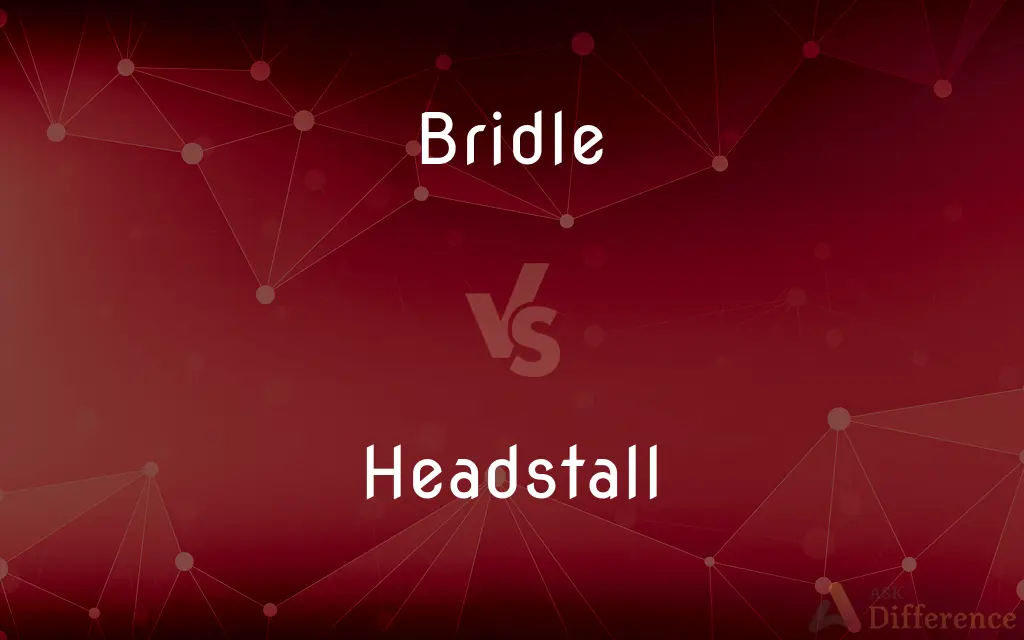Bridle vs. Headstall — What's the Difference?
By Fiza Rafique & Maham Liaqat — Updated on April 4, 2024
Bridle is a full headgear for horses, including reins and bit; headstall is part of a bridle, holding the bit.

Difference Between Bridle and Headstall
Table of Contents
ADVERTISEMENT
Key Differences
A bridle is an essential piece of horse tack used for directing a horse. It consists of various components, including the headstall, bit, and reins, which work together to allow a rider to communicate with and control the horse. The bridle fits over a horse's head and is a key tool in equestrian activities, ensuring the safety and direction of both horse and rider. Whereas, a headstall is a specific part of the bridle. It is essentially the strap that goes over the horse's head, holds the bit in the horse's mouth, and connects to the reins. It does not include the bit or reins itself but is crucial for holding the bridle together.
While the bridle is a complete set that encompasses all necessary components for horse control and communication, the headstall plays a critical role within this setup but lacks functionality on its own without the bit and reins. This distinction highlights the headstall's role as a supportive component rather than a standalone tool for direct horse management.
The selection of a bridle for a horse involves considering the entire assembly and how it fits and functions, including the type of bit and the reins' design. In contrast, choosing a headstall focuses more on the fit around the horse's head and compatibility with the chosen bit and reins. The material, durability, and comfort of the headstall are significant factors in this choice.
In addition, while bridles are distinguished by their type and the disciplines they are designed for (such as Western or English riding), headstalls are often selected based on their construction and design, which can include various fastenings and adjustments for size and comfort. This differentiation underscores the broader functionality and application of bridles in comparison to the more focused and specific utility of headstalls.
The terminology and usage of bridles and headstalls reflect their roles within equestrian equipment. "Bridle" refers to the complete equipment set for horse control, recognized across various riding styles and disciplines. In contrast, "headstall" is a term used within the context of bridle assembly and maintenance, indicating its supportive yet indispensable role in equestrian gear.
ADVERTISEMENT
Comparison Chart
Definition
Complete headgear for horses, including bit and reins.
Part of a bridle that holds the bit and connects to reins.
Components
Bit, reins, headstall, and sometimes additional straps.
Main strap over the horse's head, buckles, and attachments.
Functionality
Used for controlling and communicating with the horse.
Supports the bit in the horse's mouth; integral to the bridle.
Selection
Based on riding style, horse size, and control needs.
Focused on fit, material, and bit compatibility.
Usage
Essential for riding and handling horses.
Essential component of the bridle, but not used alone.
Compare with Definitions
Bridle
Includes bit and reins.
Choosing the right bridle involves selecting the appropriate bit for the horse's training level.
Headstall
Connects to the reins.
The headstall's rings or hooks allow for the attachment of reins.
Bridle
Varies by riding discipline.
Western bridles differ from English bridles mainly in style and bit type.
Headstall
Part of a bridle.
The headstall needs to be properly adjusted to keep the bit in the correct position.
Bridle
Comprises multiple parts.
The bridle's effectiveness depends on the correct assembly of its parts, including the headstall.
Headstall
Focused on fit and comfort.
Choosing a headstall with padding can prevent rubbing and discomfort for the horse.
Bridle
Used for control and communication.
A well-fitted bridle can significantly improve the rider's communication with the horse.
Headstall
Holds the bit in place.
A loose headstall can cause the bit to move uncomfortably in the horse's mouth.
Bridle
Full horse headgear.
The rider adjusted the bridle to make sure it fit comfortably on the horse.
Headstall
Material and design vary.
Leather headstalls are popular for their durability and traditional appearance.
Bridle
A bridle is a piece of equipment used to direct a horse. As defined in the Oxford English Dictionary, the "bridle" includes both the headstall that holds a bit that goes in the mouth of a horse, and the reins that are attached to the bit.
Headstall
The section of a bridle that fits over a horse's head. Also called headpiece.
Bridle
The headgear used to control a horse, consisting of buckled straps to which a bit and reins are attached
Grooms came at once to take the bridles
Headstall
The part of a bridle that fits over a horse's head and supports other elements.
Bridle
Put a bridle on (a horse)
Five horses, saddled and bridled, were tied by the reins to branches of trees
Headstall
(obsolete) A phorbeia.
Bridle
Show one's resentment or anger, especially by throwing up one's head and drawing in one's chin
She bridled at his tone
Headstall
That part of a bridle or halter which encompasses the head.
Bridle
A harness, consisting of a headstall, bit, and reins, fitted about a horse's head and used to restrain or guide the animal.
Headstall
The band that is the part of a bridle that fits around a horse's head
Bridle
A curb or check
Put a bridle on spending.
Bridle
(Nautical) A span of chain, wire, or rope that can be secured at both ends to an object and slung from its center point.
Bridle
To put a bridle on.
Bridle
To control or restrain
Could not bridle his excitement at the news.
Bridle
To lift the head and draw in the chin in anger or resentment.
Bridle
To be angry or resentful; take offense
Bridling at the criticism.
Bridle
The headgear with which a horse is directed and which carries a bit and reins.
Bridle
(figurative) A restraint; a curb; a check.
Bridle
A length of line or cable attached to two parts of something to spread the force of a pull, as the rigging on a kite for attaching line.
Bridle
A mooring hawser.
Bridle
A gesture expressing pride or vanity.
Bridle
(transitive) To put a bridle on.
Bridle
(transitive) To check, restrain, or control with, or as if with, a bridle; as in bridle your tongue.
Bridle
(intransitive) To show hostility or resentment.
Immigrant-rights and religious organizations bridled at the plan to favor highly skilled workers over relatives. (Houston Chronicle, 6/8/2007)
Bridle
(intransitive) To hold up one's head proudly or affectedly.
Bridle
The head gear with which a horse is governed and restrained, consisting of a headstall, a bit, and reins, with other appendages.
Bridle
A restraint; a curb; a check.
Bridle
A span of rope, line, or chain made fast as both ends, so that another rope, line, or chain may be attached to its middle.
Bridle
To put a bridle upon; to equip with a bridle; as, to bridle a horse.
He bridled her mouth with a silkweed twist.
Bridle
To restrain, guide, or govern, with, or as with, a bridle; to check, curb, or control; as, to bridle the passions; to bridle a muse.
Savoy and Nice, the keys of Italy, and the citadel in her hands to bridle Switzerland, are in that consolidation.
Bridle
To hold up the head, and draw in the chin, as an expression of pride, scorn, or resentment; to assume a lofty manner; - usually with up.
By her bridling up I perceived she expected to be treated hereafter not as Jenny Distaff, but Mrs. Tranquillus.
Bridle
Headgear for a horse; includes a headstall and bit and reins to give the rider or driver control
Bridle
The act of restraining power or action or limiting excess;
His common sense is a bridle to his quick temper
Bridle
Put a bridle on;
Bridle horses
Bridle
Respond to the reins, as of horses
Common Curiosities
What's the difference in materials between bridles and headstalls?
Both can be made from various materials, such as leather or synthetic fabrics, but the choice depends on durability, comfort, and appearance preferences.
How does the bit attach to the headstall?
The bit is attached to the headstall through rings or hooks at the ends of the headstall, allowing for easy connection and adjustment.
Are all bridles compatible with any headstall?
Most bridles and headstalls are interchangeable within the same riding style, but compatibility depends on size and design.
Can you use a headstall without a bridle?
No, the headstall is a component of the bridle and is not functional without the bit and reins.
Is it necessary to use a specific type of bridle for competitive riding?
Yes, different equestrian disciplines may have specific rules regarding bridle types, including the headstall and bit.
How does a rider communicate with a horse using a bridle?
Through subtle cues and signals via the reins, bit, and headstall, allowing for precise control and direction.
Can the type of headstall affect the horse's comfort?
Yes, the fit, material, and design of the headstall can significantly impact the horse's comfort, especially around sensitive areas like the ears and poll.
What role does the headstall play in equestrian safety?
A properly fitted headstall ensures the bit functions correctly, crucial for safe riding and handling of the horse.
How often should headstalls be replaced?
Dependent on the material's durability and the frequency of use, but regular inspections can help determine wear.
How do you choose the right bridle for a horse?
Consider the horse's size, the rider's experience, the discipline (Western or English), and the horse's sensitivity.
Can headstalls be used with different types of bits?
Generally, yes, but the headstall must be compatible with the size and style of the bit used.
What innovations have been made in bridle and headstall design?
Innovations include ergonomic designs that reduce pressure on sensitive areas, quick-change systems for bits, and materials that enhance comfort and durability.
How do you properly fit a headstall on a horse?
Ensure the headstall allows the bit to rest comfortably in the horse's mouth without pinching the cheeks or pulling too tightly on the horse's head.
Do professional riders prefer a specific type of headstall?
Preferences vary based on discipline, horse sensitivity, and personal experience, focusing on functionality and comfort.
What maintenance is required for bridles and headstalls?
Regular cleaning and conditioning, especially for leather components, to prevent wear and ensure longevity.
Share Your Discovery

Previous Comparison
Wealth vs. Prosperity
Next Comparison
Emphasised vs. EmphasizedAuthor Spotlight
Written by
Fiza RafiqueFiza Rafique is a skilled content writer at AskDifference.com, where she meticulously refines and enhances written pieces. Drawing from her vast editorial expertise, Fiza ensures clarity, accuracy, and precision in every article. Passionate about language, she continually seeks to elevate the quality of content for readers worldwide.
Co-written by
Maham Liaqat













































